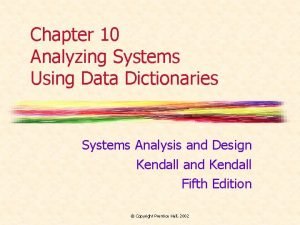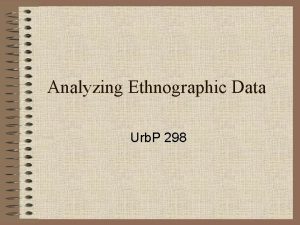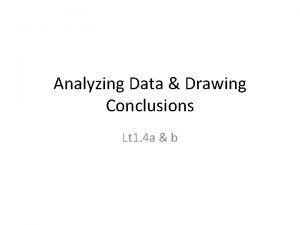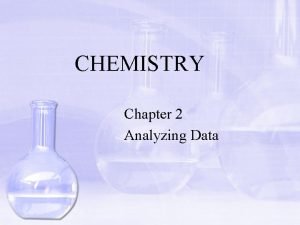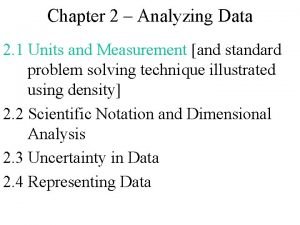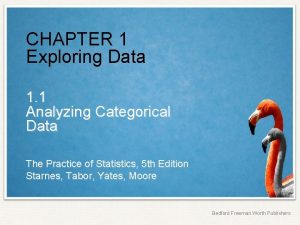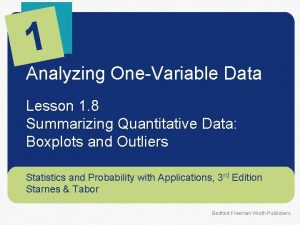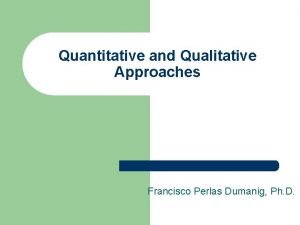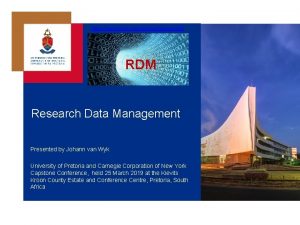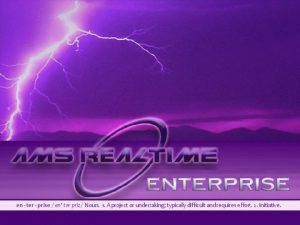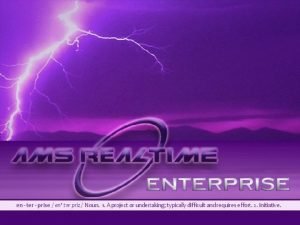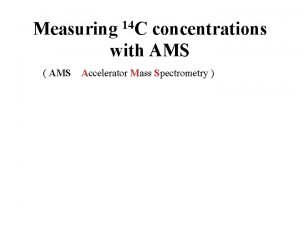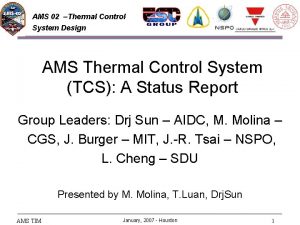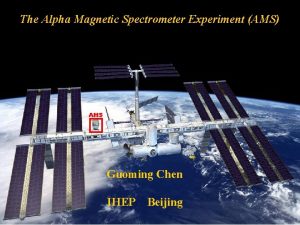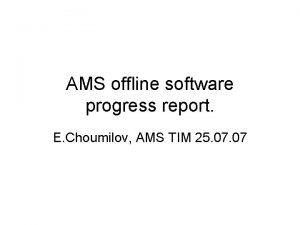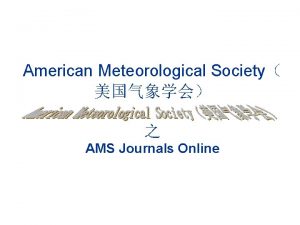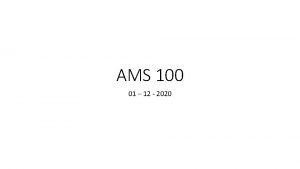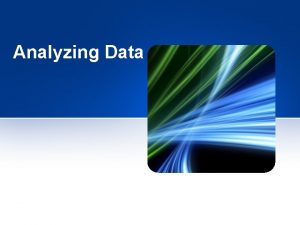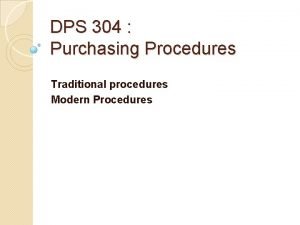Analyzing data using AMS analysis procedures Qi Zhang


















- Slides: 18

Analyzing data using AMS analysis procedures Qi Zhang June 22, 2004

Download the Latest AMS Analysis Template • Latest version from James’ website: – Analysis Toolbox version 1. 30 • Load data, apply corrections to the data and to generate relevant plots – Diagnostics version 1. 1. 7 a • Plot important m/z ratios for each specie of interest. These plots are used to optimize fragmentation waves to ensure accurate mass concentration calculations – Delta Analysis version 5. 3. 7 b • Analyze the organic components of the measured mass spectra. – Batch file 031031 • fragmentation, batch, and color waves for use with the AMS analysis toolbox (more info see James’ website) – ARI's preferred default values (e. g. , in corrections tab).

Loading Data • Load data without applying corrections (uncheck “Invoke corrections”) • Look at diagnostics plot: – multiplier voltage/gain – Heater Bias – Ionization effieciency – Duty cycle – flow rate – MS & TOF air beam.

Corrections (MS) • Airbeam correction – Set “Air beam reference runs” – Check all 3 check boxes in the section – Smoothing (by judgment) usually: Smooth MS air beam (4 pts), TOF air beam (6 pts), and Flow rate (4 pts) – Flowrate offset is instrument dependent and needs to be checked per instrument. If the offset is unknown, enter 0. 0 – Click “Recalculate” – Look at the correction factors plot Correction factor = signalt / signal 0 (The correction factors for the full experiment are referenced to the signal over the selected air beam range) – unclick the ‘Auto-set’ checkbox under “Reference Values”

Corrections (MS) • Generate a time series – Under “MS” tab; Time Series” subtab – Check and uncheck the “Use MS correction factors” checkbox, see the difference. (When MS correction is checked, time series plot should shift in agreement with the ‘MS’ correction factor values). – Closely examine the filtered air period. • Modify frag table (e. g. , frag_CO 2 [mz 44], frag_RH[m/z 18] • Check mass spec. (org 27, org 29 …)

Corrections (MS) • Create average MS for the entire period. – Type in the run number interval – Type in “Species” (Air, Water, NH 4, NO 3, SO 4, Org, Chl) – Check the ‘Add Discrepancies’ checkbox • to determine if the fragmentation waves over predict signal at any given m/z (black sticks) • to determine the MS signal that is not assigned to a particular species via the fragmentation waves (yellow sticks). – Ensure that the checkbox ‘Plot new graph’ is checked – Click ‘Calculate!’ button to generate an Average MS plot. • Examine the Mass specifically for black and yellow sticks. • Examine the Mass spec of the filtered air period. – Choose the run number interval (can use the marquee function on the ‘MS Time Series’ plot). – Look for problems, pay special attention to the organics

Corrections (MS) • Error analysis. – The ‘sigma’ and ‘background’ (background electronic noise level) values are instrument dependent and can be determined experimentally when sampling through a particle filter. Typical values are Sigma factor = 1. 2 and Background = 1 e-5. • Recalculate sticks – The default list “ 14, 18, 28, 149, 182, 184, 186” is for “open + closed”. – You have to take out 149, 182, 184 and 186 from the list of m/z's used if you do the stick recalculation but only apply it to the difference spectra. This is because these peaks only feature in the background and not the sampled aerosol. Watching the correction factors plot for large changes that may indicate mass scale issues – Check time series, Mass spec for changes – (How to undo recalculate sticks without reloading the data) • Baseline correction: – usually unchecked. Only use when some funny thing happened to baseline • Pre vs. Post corrections – The 'pre correction' box specifically for the wire analysis. It is mainly for functions to perform before the corrections are made, but after any data has been loaded. – The 'post correction' box is most useful for overwriting the ioneff_ref wave in James’ program (talk to me later for details)

Corrections (MS) • Check for bad points • Discard bad/unwanted points – Find the point number(s) on the correction factors plot (use ctrl-i). – Read off Run Number(s) (use “List” button to bring up a table of the Run Numbers (rn_series) and the Save Times (t_series). – type this Run Number into the ‘Run number(s)’ input string – Click the ‘Discard’ button. – Click ‘Recalculate!’ button to update the “Correction Factor” plots

Corrections (TOF) • Recalculate Da – Type in right values from your size calibration – “t=0 offset” to correct for the situation (not often but could happen) when the chopper starting time was not set right. The value can be measured. • Check “Clean TOF signals” (to remove bad points) • Check “override DC Markers” (to set the right zero level) • E. g. , those have big gas phase contribution need to be included in “Region 2 only Channels” correction; those suffer slow evaporation need to be included in “Region 1 only Channels” • Force DC Marker position (talk to me later for details)

Batch Table and Calibration Factors • Batch table defines the calibration factors (CAL_Fac, wname = CALfac_list) for species. – IE_fac (wname = IEfac_list): ionization efficiency. – CE_fac (wname = CEfac_list): collection efficiency CAL_fac = 1 / (IE_fac * CE_fac) – The mass concentration for a given species = S(nitrate equivalent mass concentration signal for each of its fragments) * CAL_fac. – Read Jose’s Ambient paper and James’ JGR Quantitative paper (I) for details

Fragmentation Table • Fragmentation table defines the matrix that is used to deconvolve the average ensemble mass spectra obtained by the AMS into partial mass spectra for distinct (and groups of) chemical species. – Read James’ Technical note for details – The fragmentation waves have been carefully defined based on mass spectra taken under high and low loadings in each case. – But there are four main parameters, defined as separate fragmentation waves (frag_NH 4_16, frag_CO 2, frag_O 16, and frag_RH), that must be optimized by users to ensure accurate mass concentrations for the water, ammonium, nitrate, SO 4, and chloride. – The best method for checking and optimizing these parameters is to use the Data Diagnostics panel to generate and plot the relevant m/z ratios for each species (use Alice’s Diagnosis routines).

Fragmentation Pattern of Species • Water: – The purpose of understanding H 2 O fragmentation patterns very well is to establish accurate measurements for NH 4. – H 2 O signals in the AMS can come from four sources: • • gas-phase water (RH species) sulfate or sulfuric acid Organics Particle bound water – m/z 17/18 ratio gets larger for pure water particles and is a function of the ambient relative humidity. – Typical values 17/18 ratio for water = 0. 25 16/18 ratio for water = 0. 04, and these values are defined in elements frag_RH[17] and frag_RH[16], respectively – If the relative humidity was monitored during an experiment, these factors in frag_RH can be adjusted to account for the changing ambient RH.

Fragmentation Pattern of Species • NH 4: – NH 417/16 ratio is conserved throughout an experiment (~1. 1). – 16 is the best for NH 4, may have a contribution of 16(O+). – The 16(O+) contribution is variable due to changes in the air beam intensity and may be instrument dependent. – The 16 O+ contribution must be set using the factor in element frag_O 16[16], where the contribution is tied to the variations in the 14 N signal through frag_air[14] – m/z 17 signal is a combination of H 2 O and NH 4 intensities. – Its best to use both m/z 16 and 17 to derive NH 4 concentrations by defining the element: frag_NH 4[16]= frag_NH 4_16[16], 0*1. 1*frag_NH 4[16] – With this definition for NH 4, adjust the factor in element frag_O 16[16] until the NH 4[17]: NH 4[16] data falls on the 1. 1: 1 line. This adjustment accounts for instrument variability in air beam intensity and ensures accurate ammonium and water signals. – If the H 2 O signal is compromised by complications, its best to use m/z 16 to establish NH 4 concentrations by defining the element: frag_NH 4[17]= 0*frag_NH 4_16[16], 1. 1 * frag_NH 4[16]

Fragmentation Pattern of Species • NO 3: – Nitrate mass concentrations is derived from 8 fragments, including nitric acid, NO 2, NO, and 14 N+. – The nitrate m/z 46/30 ratio is typically between 3 and 6. • SO 4: – Due to different mechanisms for the evaporation and ionization of SO 4 from particles (evaporation of sulfuric acid vs. SO 3 from the oven), two fragmentation waves have been defined for SO 4 (frag_H 2 SO 4 and frag_SO 3). These fragmentation waves are combined using the frag_SO 4 wave, and take into account some 25 m/z signals. – The purpose of being so thorough on the SO 4 fragmentation is to ensure accurate organic signals at each m/z. – Because of the different mechanisms, the m/z 48/64 ratio is not conserved for SO 4. – Evaporated H 2 SO 4 will fragment with 81/48 and 81/64 ~ 1. 0 to 1. 5, – whereas evaporated SO 3 will fragment with 81 / 48 and 81/64 ~ 0. 2

Fragmentation Pattern of Species • Chl: – Currently, chlorides mass concentrations are derived from the signal intensities at m/z 35, 36, 37, and 38. The two evaporation and ionization mechanisms for chlorine is either through evaporation of HCl from the oven surface and the formation of HCl+ ions (m/z 36 and 38). – This mechanism most likely occurs when the chlorine is bound up in volatile or semi-volatile inorganic compounds such as NH 4 Cl. – Chloride ions can also be generated in the gas phase from chlorine containing organic compounds (m/z 35 and 37).

Fragmentation Pattern of Species • Other Metals: – Due to unique fragmentation patterns, metal ions are usually fairly easy to identify within a mass spectrum and thus can be accounted for by generating a fragmentation wave for the metal. – Although metal ions are not observed in large quantities in ambient aerosol, there are several specific cases where they are important: (1) variable oven temperature experiments, and (2) source characterization. – Variable oven temperature experiments are carried out to investigate the evaporation kinetics of semi-volatile components in ambient aerosol. The oven consists of tungsten, and thus under high temperature conditions, tungsten oxides, and potential tungsten chlorides must be account for as an experimental contamination. – Source characterization experiments, such as incinerator emission experiments, can potentially measure many different metal compounds, which again can be identified and taken into account by generating relevant fragmentation waves.

Data Analysis (MS) • Generate Time Series – Check “use MS correction factor” – Simple Time Trends (note: you can plot any mass ratio, e. g. , 28/44 to plot 28 m/z over 40 m/z) – Mass Calculation • Species • Graph option • Diurnal plots

Data Analysis (TOF) 4 choice, x waves dsig and tsig. Smooth along the diameter axis Smooth along the time axis Gives the area under the plot. Ask me for the macro that can calculate mass conc. in a given size range The noise is calculated by looking at the standard deviation of the data points within the TOF regions while the data is in TOF space and mapped accordingly to log(d) space (see James JGR Quantitative paper). This noise is based on the electronic noise and the ion counting statistics of the background, so is really best suited to calculating detection limits rather than absolute uncertainties. Delete the intermediate waves that have been produced.
 Chapter 2 analyzing transactions
Chapter 2 analyzing transactions 13-1 work together p. 381
13-1 work together p. 381 Example of data dictionary in system analysis and design
Example of data dictionary in system analysis and design Analyzing and using marketing information
Analyzing and using marketing information Managing customer information to gain customer insights
Managing customer information to gain customer insights Procedures of contrastive analysis
Procedures of contrastive analysis Analyzing ethnographic data
Analyzing ethnographic data Analyze data and draw conclusions
Analyze data and draw conclusions Chapter 2 analyzing data
Chapter 2 analyzing data Chapter 2 analyzing data answer key
Chapter 2 analyzing data answer key Analyzing and visualizing data with microsoft power bi
Analyzing and visualizing data with microsoft power bi Interpreting quantitative data
Interpreting quantitative data Analyzing categorical data
Analyzing categorical data Analyzing one variable data
Analyzing one variable data Types of quantitative research designs
Types of quantitative research designs Analyzing and interpreting data in research
Analyzing and interpreting data in research Analyzing and interpreting data in research
Analyzing and interpreting data in research Analyzing and interpreting data in research
Analyzing and interpreting data in research Analyzing and interpreting data in research
Analyzing and interpreting data in research


